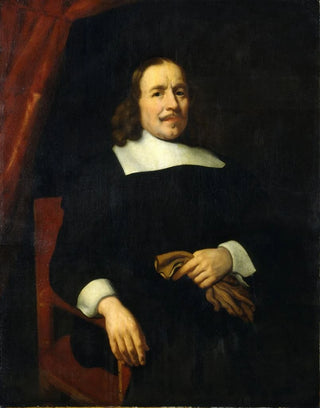Art print | Dutch Gentleman - Nicolaes Maes


View from behind

Frame (optional)
In the captivating world of 17th-century Dutch painting, the "Gentleman hollandais" art print by Nicolaes Maes stands out for its striking realism and intimate atmosphere. This artwork, embodying the essence of bourgeois portraiture, invites us to delve into daily life in the Netherlands during a time of thriving commerce and culture. The soft light enveloping the main figure creates an immediate connection with the viewer, evoking curiosity and admiration. Contemplating this piece transports us to a world where every detail matters, and every shadow tells a story.
Style and uniqueness of the art print
Nicolaes Maes's style is characterized by an exceptional mastery of light and texture, techniques that reveal the psychological depth of his subjects. In "Gentleman hollandais," the artist highlights not only the face of the protagonist but also the nuances of his costume, which demonstrate remarkable craftsmanship. Carefully rendered drapery and the play of light on fabrics emphasize the richness of bourgeois life at that time. This art print is more than just a portrait; it captures the very essence of Dutch identity, where the individual is both a representative of his era and a reflection of his values. Thus, Maes manages to transcend mere stylistic exercise to offer a profoundly human and touching work.
The artist and his influence
Nicolaes Maes, a pupil of Rembrandt, established himself in the artistic landscape of his time through his innovative approach to portraiture. Although his early works were influenced by his master, he quickly developed a style that was uniquely his own, blending realism and intimacy. Maes captured the spirit of his era, becoming one of the most sought-after portraitists of his time. His influence extends beyond his own work, inspiring generations of artists seeking to explore the complexity of the human soul through portraiture. By rediscovering works like "Gentleman hollandais," we better understand Maes's lasting impact on European art and how his legacy continues to resonate.

Matte finish

View from behind

Frame (optional)
In the captivating world of 17th-century Dutch painting, the "Gentleman hollandais" art print by Nicolaes Maes stands out for its striking realism and intimate atmosphere. This artwork, embodying the essence of bourgeois portraiture, invites us to delve into daily life in the Netherlands during a time of thriving commerce and culture. The soft light enveloping the main figure creates an immediate connection with the viewer, evoking curiosity and admiration. Contemplating this piece transports us to a world where every detail matters, and every shadow tells a story.
Style and uniqueness of the art print
Nicolaes Maes's style is characterized by an exceptional mastery of light and texture, techniques that reveal the psychological depth of his subjects. In "Gentleman hollandais," the artist highlights not only the face of the protagonist but also the nuances of his costume, which demonstrate remarkable craftsmanship. Carefully rendered drapery and the play of light on fabrics emphasize the richness of bourgeois life at that time. This art print is more than just a portrait; it captures the very essence of Dutch identity, where the individual is both a representative of his era and a reflection of his values. Thus, Maes manages to transcend mere stylistic exercise to offer a profoundly human and touching work.
The artist and his influence
Nicolaes Maes, a pupil of Rembrandt, established himself in the artistic landscape of his time through his innovative approach to portraiture. Although his early works were influenced by his master, he quickly developed a style that was uniquely his own, blending realism and intimacy. Maes captured the spirit of his era, becoming one of the most sought-after portraitists of his time. His influence extends beyond his own work, inspiring generations of artists seeking to explore the complexity of the human soul through portraiture. By rediscovering works like "Gentleman hollandais," we better understand Maes's lasting impact on European art and how his legacy continues to resonate.






